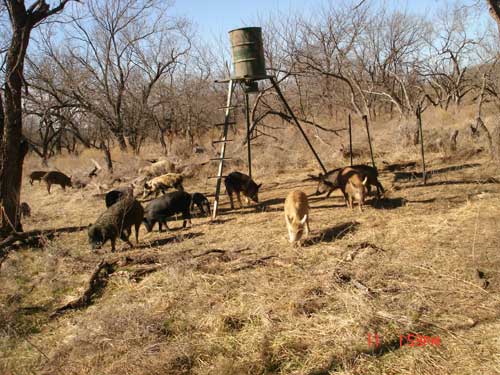Warfarin was recently approved for feral hog control in Texas. The chemical, which is used as a blood thinner in humans and as the active ingredient in rat poison, is also quite toxic on wild pigs. But just like other feral hog control measures, the idea is no quick fix. Many organizations have issues with warfarin, including the Texas Wildlife Association (TWA).
In fact, TWA recently released a statement concerning the use of warfarin for hogs:
TWA on Warfarin in Texas
“TWA recognizes the ecological and agricultural damage that feral hogs create across Texas. As such, TWA is a staunch proponent of effective and responsible control of feral hog populations. However, the recent announcement by the Texas Department of Agriculture approving the use of a Warfarin-based feral hog toxicant is cause for concern.
Warfarin has a highly variable lethality, often taking several days before eventual death. This creates opportunity for Warfarin to reach non-target species, including carnivores who prey on poisoned animals, carrion feeders that consume poisoned carcasses, and even humans who harvest and consume poisoned animals.

The proposed commercial Warfarin-based feral hog toxicant, Kaput Feral Hog Bait, carries a label requiring several practices that TWA finds concerning and impractical.
First, the “Environmental Hazards” statement on the label notes possible toxicity to fish, birds, and other wildlife. The “Bait Application” statement requires collection and disposal of spilled bait around the feeders every 1 to 4 days. Both of these statements taken in context with a bait delivery apparatus that is easily defeated by wildlife other than feral hogs lead TWA to believe there is real risk of non-target species consuming Warfarin. Likely non-target wildlife would include small mammals and birds, which could in turn be consumed by other mammal, bird, and reptilian predators or scavengers.”
Second-Hand Warfarin Consumption?
The “Surveillance and Follow-up” requirements recommend disposal of the poisoned carcasses by burial or other methods to ensure they are not accessible to scavengers. The length of time between consumption of poison by hogs and the actual death of the pig may take several days and makes this requirement effectively impossible, virtually ensuring non-target species impact.
Taken in whole, many believe the use of a Warfarin-based feral hog toxicant as proposed poses far too great of a risk to the wildlife ecology of Texas. And it’s hard to dispute that concern. Of course, there is also potential for public concern over real human health risks. That could slow hog hunting participation as well as other feral hog control methods such as recreational and commercial trapping.
There are some solid points that dispute the “clearance” of warfarin for hogs in Texas. TWA even stated, “We strongly urge further scientific review and transparent due diligence before proceeding with the use of any warfarin-based toxicant for feral hog control purposes.” TWA also supports bills recently filed in the Texas Legislature (SB 1454 and HB 3451) that seek to mandate such a review process.
Will the use of warfarin impact feral hog control in Texas? Will hog hunting participation suffer from the use of warfarin? It’s impossible to say right now since it appears warfarin still has a ways to go before it ever has a chance to actually be used on the landscape. Research continues regarding the use of sodium nitrite for wild hogs, although it’s not clear when it will be available either.
No .. poison is not the answer in any way.. There are Hungry People here in the US and even more abroad.. Pay a meaningful bounty and harvest them for food.. There are many indications that we may be headed into a deliberate economic downturn if not a depression.. These Hogs should be seen as means to feed people..
Wm, it’s a good idea to use this free ranging protein to feed people. One would really have to evaluate the economics of it at scale to see if it can work. If they were that easy to round up then perhaps we would not have a pig problem. Good idea though.